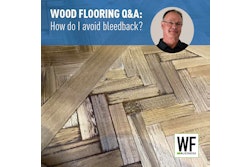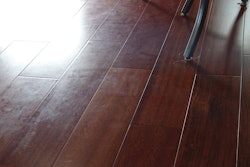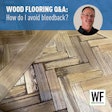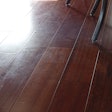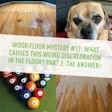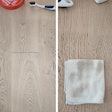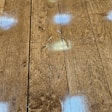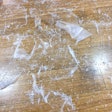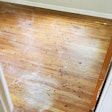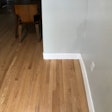The Problem
We received a call from a contractor who was nearly in tears with frustration because he thought he might have to quit the business—he couldn't seem to put down finish anymore without it fish-eyeing and separating.
The problem had started about a month before, right out of the blue, after many years of successful contracting. The strange part was that in this family business, where everyone—husband, wife, and son—was involved in all aspects of the sanding and finishing, the only one with finish problems was the husband. The fish-eyes were spaced consistently throughout each floor,and the problem had repeated on every job that he had coated since that point. He and the family were at wits' end to find a solution… or a new career.
The Procedure
The contractor's steps and techniques in sanding and preparing the floors were by the book,so we couldn't pinpoint possible causes in this area. Everything on the job proceeded like clockwork until it came time to apply the finish.
For the next three to four weeks, we exchanged phone calls with the contractor and with numerous technical and contractor personnel at our company and throughout the entire wood flooring industry. We would discuss one possible cause and have the contractor try something else on the next job, but without success. The fish-eyes would reliably appear in the finish on every job. His frustration and fear of having to give up his profession grew with each setback. It was happening on every job—it didn't matter whether he was sanding and finishing or abrading and recoating.
We ran through the gamut of possible causes:maintenance contamination, applicator contamination, tacking solvent still left on the floor, using a poor-quality tacking solution, contamination being tracked in from shoes or transferred from a screen or pad, finish being applied too thin, stain not being dry enough, and finish contamination from an outside source. Running out of possible explanations, we all were starting to reach pretty far to find a cause and solution. We even went so far as to suggest that the contractor try other brands of finish—but the fish-eyes still appeared.
The Cause
Having exhausted all of the normal possibilities and then some, it was time to get personal—in fact, it proved to be very personal. It just so happened that the head of our lab recently had attended a coatings conference, where he heard about a similar situation in the automotive paint industry. It seemed that a particular automotive shop was having problems with its paint having fish-eyes on nearly every job. Through their troubleshooting efforts, it was discovered that certain perfumes, colognes and deodorants worn by the paint mechanics were the cause of the paint defect issues. When the mechanics changed these variables, the defects no longer occurred.
So, if this could be it, what was the connection between the husband and any personal products that only he used? New cologne? Laundry detergent? Special diet? Shampoo? Soap? Deodorant? Hairspray or gel? The list was pretty long, so we decided to start by asking if he had changed any of these products in the recent past. You could almost hear the light go on in his head and the sound of relief in his voice as he said, "Yes, in fact, I did change my deodorant, and I can tell you the exact day I changed, too: the day I started having these problems."
He called the next day, nearly in tears again, to let us know that he had changed back to his old deodorant and had just coated a floor without getting fish-eyes. It seemed that some ingredient in the new "anti-perspirant" deodorant, coupled with the fact that he regularly coated floors without his shirt on due to the heat in his area, was the cause of his finish problems. The powdery,anti-perspirant particles would fall into the finish during application, causing the finish to separate and take on the "fish-eyed" appearance.
How to Fix the Floor
The floors that were affected by the fish-eyes were reparable by a simple abrade and recoat,done by another member of the family before the deodorant cause was determined. The big problem here wasn't fixing the floors, but discovering the cause and preventing it from happening again.
In the Future
Sometimes the problem isn't related to species,preparation steps, finishing products, dry times or cure times, maintenance products, applicators, ventilation, outside contamination, etc. Sometimes the problem is right under your nose,or fairly close.














